Phoenix Bird Control
Welcome to Bird Removal of Phoenix! We specialize in the humane and effective resolution of human/bird conflicts in the Phoenix metro region, and throughout Arizona. Whether you have a single bird in a building, or need to prevent pigeon roosting (and bird droppings) on a large architectural project, we can solve your Phoenix bird problem effectively and professionally. We install exclusion materials to keep birds away, and even provide pigeon trapping as a means of Phoenix bird removal. We are not a pest control company, but rather wildlife, bat, and bird specialists only. Click on our Phoenix Prices page to find out more about our prices for bird control work. You can also read the topics addressed on this website to learn more about how to resolve your specific bird conflict. We look forward to hearing from you.
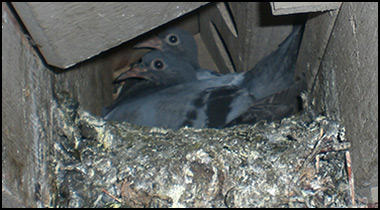
Phoenix Bird Removal & Structural Repairs
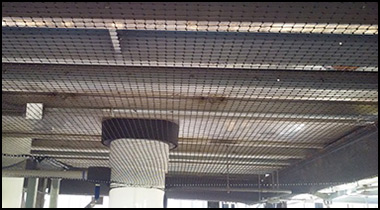
Exclusion Netting & Spike Installation
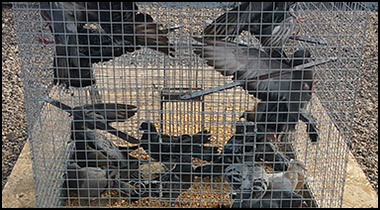
Arizona Bird Trapping & More
Call 24/7 to discuss your Phoenix bird problem.
Same-day or next-day appointments: 602-313-8971
Thorough inspection of your property.
Written estimates for bird project.
Fully Arizona licensed and insured.
Structural bird exlusion netting.
Anti-roosting spikes and shock track.
Aurel dispersion and bird harrassment.
Bird dropping cleanup and sanitation services.
Bird damage repair and building exclusion.
Our Service Range - 602-313-8971
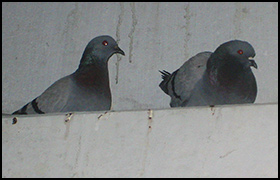
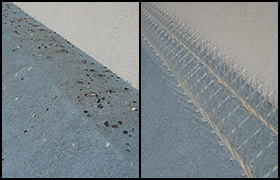
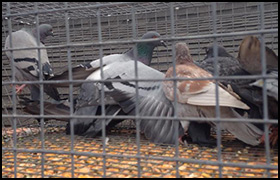
For bird control and general wildlife removal, visit the Phoenix Pest Animal website.
Biology of Pigeon
Pigeon is one of the most popular in the bird family and they have many species. The size of adult pigeon varies from one species to another. Rock pigeon is known to be about 32-37 cm long and 64-72 cm for the wingspan. Also their colors differ as some are white color while others come with mix of many colors. The rock pigeon has dark bluish-grey head, glossy neck and chest with greenish and reddish-purple color with iridescence around the neck as well as the wing feathers. The Juveniles are known to have grayish brown or brown iris while the adults have red or orange with pale inner ring. They have red legs and peg with distinctive twin black wing bars as well as white feathers at the lower back.
Biology, Life Cycle
Pigeons are known to breed all year round with the peak breeding season being in the summer and spring. The entire columbiformes are known to be monogamous and some of them normally breed on a coastal cliffs or even inland cliffs. Some even breed on building mainly in the urban area. They normally lay tow eggs which are incubated by both male and female pigeon for about 17-19 days. After the incubation period the eggs are hatched and the babies will come out and live about 6 months to start breeding. The life expectancy of pigeons differs from one species to another and depending on the environment. Come can live as much as 31 years while others like rock pigeon can live for 2.4 years and Kansas birds are known to live for about 6 years 2 weeks.
Habitat
There are wild and domesticated pigeons. The domestic rock pigeons are known to live in urban areas, rocky cliffs, farmland and others. They usually gather themselves in large flocks right in urban parks where they are feed frequently by people. For wild pigeons they are found in the coastal areas. Feral pigeon is mostly found in human inhabitation.
Diet
Seed is the main components of pigeon diet. But there is variation in the things each species like to feed on. Some of them normally feed on insects, worms and fruits. Some just get adapted in eating reptiles and insect. For the feral pigeons they normally live on seeds from human and refuse like waste from fast food. The wood pigeons mainly feed on berries and vegetables.
Behavior
Pigeons normally drink water through placing bill inside water and pecking foods on the ground. Pigeons can easily threaten rivals through cooing and bowing, inflating their throat at the same time walking in cycle and that same thing a male pigeon normally do while courting the female for mate. Then the male and female will preen each other while the male will grasp the female bill and showing their courtship gesture by regurgitating food. When they are ready to mate, the female will crouch while the male will jump on her back. While building nest, the male will fetch stem or swing to the female at a time and the male will help to incubate egg from mid-morning to the afternoon for the female to take over from over the night to mid-morning. Both male and female normally bring up the young together by bringing out milky liquid from the lining of their crops.

